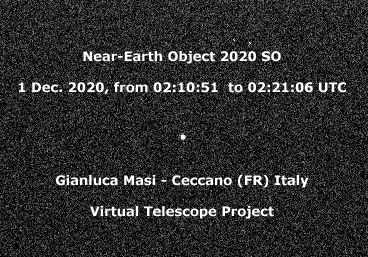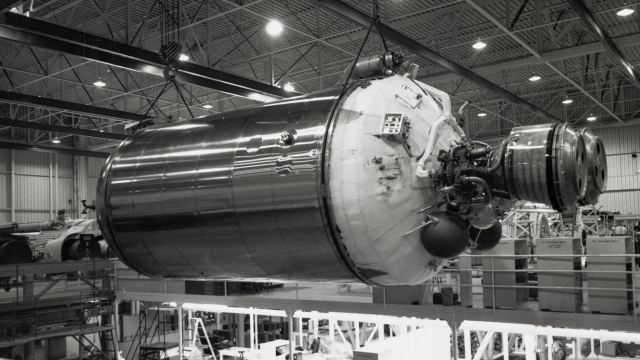An incoming object spotted by astronomers this past August has been confirmed as the upper stage of a Centaur rocket, which NASA launched in 1966 during an ill-fated mission to the Moon. It’s a neat achievement, but the confirmation took some doing.
After months of speculation, a team led by Vishnu Reddy, an associate professor at the Lunar and Planetary Laboratory at the University of Arizona, has confirmed object 2020 SO as being the upper stage of a Centaur rocket booster, as NASA reports.
It’s a fun discovery, but as Reddy explained in a phone interview, the ability to detect such objects is of scientific and practical importance.
“As humanity expands into space, we’re going to see a lot of objects that are artificial in heliocentric orbits [orbiting the Sun],” he said. “It’s essential that we know what’s coming our way, whether it’s artificial or natural.” To which he added: “This whole process shows that it’s possible to identify something that was launched 54 years ago.”

2020 SO was detected in August by astronomers working with the Pan-STARRS1 survey in Maui, Hawai’i. That the object was something artificial was immediately apparent, as it travelled along an orbit deemed unusual for asteroids. Paul Chodas, director of the Centre for Near-Earth Object Studies (CNEOS) at NASA’s Jet Propulsion Laboratory, ran some clever calculations to backtrack its recent history, finding that the object’s 1966 flyby of Earth was close enough such that it could have originated from our planet.
Alerted to this possibility — that the object might be space junk coming back to pay us a visit — NASA reached out to Reddy, who specialises in this sort of work.
“This is totally in my wheelhouse, as I characterise asteroids for NASA and space debris in Earth orbit for the U.S. Air Force,” he said.
NASA asked Reddy to confirm the object as being an asteroid or rocket body, and to do so with a spectral signature. Object 2020 SO has a very faint visual magnitude, making visual confirmations next to impossible. A spectral signature, on the other hand, conveys the actual composition of an object, providing the needed evidence to ID it.
Using the Large Binocular Telescope in Arizona, Reddy and his colleagues collected colour observations of 2020 SO, which they compared to the most common types of asteroids. The results did not match.
“But the money is in the infrared, and not in visible wavelengths,” Reddy told me.
Accordingly, the team turned to NASA’s Infrared Telescope Facility on Maunakea, Hawai’i, but they had to wait until November for the object to get bright enough. On November 17, they managed to acquire a spectrum.
Archival photos of the second stage Centaur rocket showed parts of it covered in white paint, so Reddy’s team contacted a paint company to get white paint samples. Trouble is, the spectral signature produced by these samples didn’t match the signal from 2020 SO.
“We were really scratching our heads,” said Reddy.
The team decided to contact a NASA historian, who informed them that the white stuff on the booster wasn’t paint — it was white foam paneling that was jettisoned from the vehicle during launch. Who knew?
Their next bet was to detect stainless steel, namely 301 stainless steel, which NASA used to construct the Centaur booster. Finally, the scientists were able to make a solid match.
Reddy said he gets nervous about spectrum data, so he wanted more spectrographic observations of 2020 SO to be sure, so the team once again used IRTF to scan the object on November 29 and 30. This resulted in a new absorption feature that hadn’t appeared during the scans made on November 17. This feature actually looked organic, in that it was rich in carbon. A seemingly weird result, but it dawned on the scientists — they were seeing plastic. Specifically, plastic backings on the aluminium mylar used to protect electronic components located at the top and bottom ends of the Centaur booster.
“The rocket booster is tumbling around in space,” said Reddy, “So it makes sense, as we’re seeing everything.”
But the ultimate test, he said, was to acquire spectrographic observations of other Centaur bodies that have been in Earth orbit since the 1970s. Reddy wanted an “apples to apples” comparison.
This actually proved to be very challenging, given that IRTF, with its tiny field of view, was not designed for this purpose. On December 1, Reddy, after trying and failing to pinpoint these old boosters with a backyard telescope (he almost did it, but a chimney obscured his view), his graduate student, Tanner Campbell, managed to acquire a Centaur position, which was then relayed to telescope operator Dave Griep at NASA’s IRTF. This particular upper stage belonged to a Centaur D launched in 1977. The team managed to spot and scan two more in visible light. These observations provided the matches they were looking for.
“You cannot get a better match,” said Reddy. “The same steel and plastic for all Centaurs.”
With 2020 SO now confirmed as an upper stage booster, launched as part of the Sojourner mission to explore the Moon’s surface prior to the Apollo missions, Reddy said the results are testament to astronomers’ ability to characterise such objects. It turned out to be a rather big coordination exercise, he said.
[referenced id=”1625943″ url=”https://gizmodo.com.au/2020/12/astronomer-captures-possible-image-of-nasas-long-lost-centaur-rocket-booster/” thumb=”https://gizmodo.com.au/wp-content/uploads/2020/12/02/vwxgjke8effop2ccpsgw-300×168.jpg” title=”Astronomer Captures Possible Image of NASA’s Long-Lost Centaur Rocket Booster” excerpt=”A tiny mystery object is zipping past the Earth today, providing astronomers with an excellent opportunity to finally confirm it as being the upper stage of a Centaur rocket that was launched by NASA in 1966.”]
“I’m very happy,” said Chodas in an email. “I also appreciate the efforts of my colleagues to confirm that this object really is a Centaur upper stage: It takes a team to sort out a puzzle like this.” To which he added: “This is another demonstration of the precision of our CNEOS orbital analyses and predictions, that we can link the trajectory of a new object nowadays to a launch 54 years ago.”
Amazing stuff, but clearly the result of a lot of work. Equipped with this experience, astronomers can now look forward to the next incoming artificial object, whatever it might be. As for the Centaur upper stage, it will make two loops around the Earth before resuming a new orbit around the Sun in March 2021.
